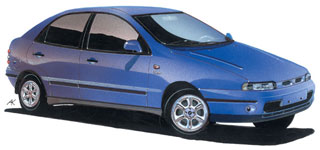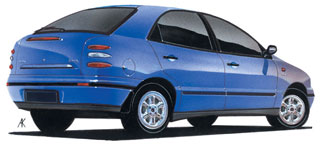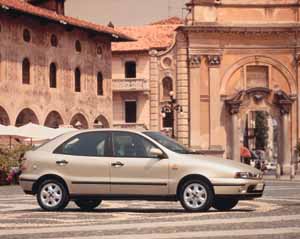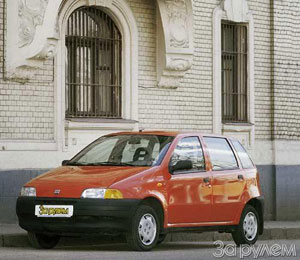Test drive Fiat Brava 1995 - 2001 hatchback
Fiat Brava (1995-2001 of release)
 Bravo, we will have a lot of work! - Services shouted with the advent of each new Fiat model. A joke with a share of the truth: a golf class from Fiat is called Brava.
Bravo, we will have a lot of work! - Services shouted with the advent of each new Fiat model. A joke with a share of the truth: a golf class from Fiat is called Brava. Brava is Fiat bravada in a golf class. Like any Italian, he is interesting outwardly, hot in temperament and not very reliable. Although in the distant 1996, a couple of Bravo/Brava won a car of the year in the European competition.
The machine has an interesting design (some rear lights are worth it!) And a spacious salon. There is enough space for the legs behind, and the three of them are not so bad. But the trunk is small, and not all Brava has the back of the seat. Therefore, you can use the car as a summer cottage very conditionally. But the car body practically does not rust - thanks to the galley.
Alas, by 150--200 thousand km of mileage, the Brava interior begins to speak the language of creaks and knocks. This will have to come to terms with this - it is almost impossible to completely eliminate extraneous noises.
Start key? There are not a lot of tricks on the electrician. Almost every car fails on the lid of the trunk ($ 14). The electrical equipment of the rear door feeds on it, so you will not be particularly pulled with the replacement. If we talked about the fifth door, then the glass gunner’s tube sometimes clogs in it. When the liquid is assembled under the casing, there is little pleasant.
Each Brava is equipped with Fiat Code. This is a factory immobilizer, which often causes a lot of trouble. The factory kit includes two blue keys, one brown and a card with codes. There are usually no keys on the backstones of all keys. They removed the battery - the system may well glue and block the motor. Without a brown key and cards, cook up to $ 1035 for a new control unit and a set of keys. With a brown key or card, it is enough to reprogram the system. As an option, in the most advanced case, you can remove the control unit from the bat. The cost of replacement will not exceed $ 35.
It happens that the buttons of the electric windows and the central lock are striking. It is not necessary to change the details, it is enough to carefully clean the contacts and treat them with liquid type WD40. It is not necessary to go to the official service for this-for $ 25-30, any competent car mechanic will cope with this.
Often, native Fiat radios fail. They are integrated into the instrument panel, and it is almost impossible to pull them out by a violent method. But when the radio is pulled out on the service, ask in return not the same ($ 354), but a special adapter ($ 8) for ordinary music. After all, the native Fiatovskaya is not impressive with the quality of the sound.
Large repair. Southerners are emotional people. And Italian cars are not deprived of this temperament. Even the weakest, with a volume of 1.4 liters, the motor very cheerfully twists each gear, although this engine is the most unsuccessful in the ruler. Buying Brava 1.4 is last-after 100-150 thousand kilometers of mileage, the engine, as a rule, requires serious repair. The budget is as follows: valve hydraulic compensators ($ 14 apiece), camshaft ($ 340), oil -like tube ($ 77), work ($ 420). When examining the machine, having heard the slightest noise of the gas distribution mechanism, turn around and leave. Or demand a discount on the amount of upcoming repairs.
The 1.6-liter unit has a personal problem-nozzles ($ 188 apiece, work-$ 57). They are electromagnetic, and after 80 thousand kmilometers often fail. Exit - in the installation of additional resistance ($ 35 along with work), which will smooth out the peaks of voltage and extend the life of nozzles. The rest of the engines has 1.6 and 1.8 liters of general defects. This is an unreliable stepping engine of a idle servo ($ 190 + $ 7) and engine speed sensors ($ 63 per 1 pc. + $ 17). In a 1.6-liter unit, a separate problem is nozzles. They are electromagnetic and after 80 thousand km begin to fail ($ 190 apiece, work - $ 58). So the 1.8-liter engine can be considered the most successful in terms of the dynamics/expenses.
After 100 thousand kilometers, it is better to change the high-voltage wires ($ 50 + $ 8), and a lambda zond ($ 177 + $ 17) is being reached by 120 thousand km.
The timing belt changes after 60 thousand kilometers ($ 58 per belt and $ 92 per videos + $ 80), but it is better to do this operation on a 1.8 liter motor early. How not to miss - listen to a stretch video. At the slightest signs of noise - to the doctor. It is recommended to do this operation on a company service. The absence of marks and the need to use the specification is not the best option for garage.
 All motors are characterized by the problems of the cooling system. Often the fan does not turn on, and thermostats ($ 75 per part, $ 76 - work) are considered consumable, but the most unpleasant - leaks. No, they happen infrequently, but here are the consequences ... When the heater radiator flows, the liquid enters the Airbag control unit. It costs $ 500, so some craftsmen simply turn it off before sale. After turning the ignition key on the instrument panel, the Airbag light should be lit. Otherwise, there was either a blow, or the control unit fails. So that there are no surprises, change the antifreeze every two years.
All motors are characterized by the problems of the cooling system. Often the fan does not turn on, and thermostats ($ 75 per part, $ 76 - work) are considered consumable, but the most unpleasant - leaks. No, they happen infrequently, but here are the consequences ... When the heater radiator flows, the liquid enters the Airbag control unit. It costs $ 500, so some craftsmen simply turn it off before sale. After turning the ignition key on the instrument panel, the Airbag light should be lit. Otherwise, there was either a blow, or the control unit fails. So that there are no surprises, change the antifreeze every two years. Unfortunately, the fuel consumption of gasoline Brava is frankly large. Therefore, diesel engines were made for fans of savings. Over the years of production, there were several of them - from simple atmospheric to complex JTD with non -constant injection and Common Rail. But diesel Brava is a rarity in Russia.
Weakness in the legs. The sky heeded the prayers of the owners of Fiat, and on Brava the checkpoint they do not know the words to flow and howl. Transmission service is reduced to control of the oil level every 20-30 thousand km, and replacing once every 2-3 years.
However, a powerful version of HGT may have defects in transmission. The most common is differential wear. Replacement-$ 350-500.
The Brava suspension has gained fame too hard for our roads. It works noisily, and a little sense. About once every 40 thousand km, the Italian will need to update the front suspension. This is expensive, since the ball support, the silent block and the lever change only in the collection. There is one such lever $ 97.
In addition, steering tips ($ 20.5 apiece), racks and bushings of reptile stability stabilizers (set - $ 18, replacement - $ 48) are suitable. Shock absorbers withstand about 70 thousand. The front costs $ 80 plus $ 24, the rear - $ 58 and $ 14, respectively.
In the rear suspension, the resource of parts is larger. The levers are able to withstand about 200 thousand km, of course, if shock absorbers are changed in time. Until this moment, if you're lucky, you will have to change only the pillows of the rear beam. Unlucky - and the bearings of the lever ($ 92 per circle).
The brakes on the car are very good. Even with drums in the back (versions 1.4 and 1.6 l). At the same time, the front pads ($ 41 + $ 15 for work) are nursing more than 30 thousand km, rear ($ 80 and $ 48 per work) - from 70 to 80 thousand km.
The steering is the usual Reika. It is not repaired and, in extreme cases, requires only aggregate replacement. However, if in time, every 30--40 thousand km, change the tips ($ 21 apiece), then the new rail will not need the entire service life of the machine.
In general, Fiat Brava does not shine with reliability, and the car suspension is too hard and loose for our roads. The same is evidenced by modern Western ratings: Brava constantly takes first places from below. But the machine is evaluated not only with a calculator. There is a moral side: the pleasure of driving, the very fun that many are missing. In this nomination of BRAVA competitors, you still need to look for: still not outdated design, the groovy nature of the engines.
Text Dmitry Novitsky, drawing Alexander Krasnov
Fiat Brava (2000 g/c) 100 16V SX 115 16V ELX
Length/width/height 4025/1755/1420
Working volume (cubic meter) 1581 1747
Power (L.S.) 103 113
Equipped mass (kg) 1165 1205
Maximum speed (km/h) 180 190
Acceleration from 0 to 100 km/h (sec.) 11.5 10.3
Fuel consumption, average (l/100 km) 8.3 8.4
The cost of spare parts and consumables for Fiat Brava 1.6 (with work)
Air filter $ 16 ($ 16.5)*
Fuel filter $ 26.5 ($ 11)
Oil filter $ 16 ($ 11.5)
A hinged belt $ 35 ($ 13.5)
Spark plug (set) $ 35 ($ 20.4)
Front brake pads $ 46 ($ 29)
Rear brake pads $ 129 ($ 30.5)
Front brake discs $ 83 ($ 30)
Front wing $ 115
Rear lamp $ 86
Front headlight $ 138
* The cost of non -original spare parts is indicated in the brackets.
Source: "Autopilot"
Video Crash tests Fiat Brava 1995 - 2001
Test drives Fiat Brava 1995 - 2001
Fiat Brava Crash Test 1995 - 2001
Krassh Test: Detailed Information16%
Driver and passengers
11%
Pedestrians








